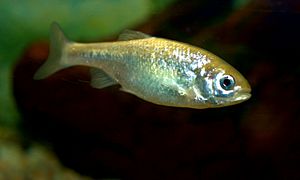Beautiful shiner facts for kids
Quick facts for kids Beautiful shiner |
|
|---|---|
 |
|
| juvenile | |
| Conservation status | |
| Scientific classification | |
| Synonyms | |
|
The beautiful shiner (Cyprinella formosa) is a small, shiny fish that lives in fresh water. It belongs to the Cyprinidae family, which includes minnows and carp. You can find this fish in parts of Mexico and the United States, specifically in Arizona and New Mexico. It's one of 22 types of Cyprinella fish found in North America.
Contents
What Does the Beautiful Shiner Look Like?
The beautiful shiner is one of the smallest native fish in Arizona. It only grows to about 3.5 inches long. This fish has a pointed snout and a body that looks a bit squished from the sides. This gives it a very thin shape.
Special Features of the Shiner
The beautiful shiner has a slightly curved lateral line. This is a special line of sensory organs along the side of a fish. It helps them feel vibrations in the water. This line has 30 to 40 small scales.
Their fins have fewer rays (the bony supports inside fins) than some other fish. The dorsal fin (on its back) and pelvic fins (on its belly) each have eight rays. The anal fin (near its tail) has eight or nine rays.
Inside their mouths, shiners have special teeth called pharyngeal teeth. These teeth line up in a single row. This unique feature helps scientists tell them apart from other fish.
Shiner Colors and Mating Changes
Beautiful shiners can be orange or bright red. They have silvery-gray lines along their sides. They also have special cells called melanophores on their backs. These cells allow them to change colors, especially during mating season.
When it's time to mate, male shiners change the color of their tail fins. They turn yellow or orange. Scientists are still studying why they do this. Sometimes, males can also have blue or red heads.
Where Do Beautiful Shiners Live?
You can usually find beautiful shiners in the waters of Cochise County in Arizona. They also live in San Bernardino Creek. For a short time in 1969-1970, these fish disappeared from the United States. This is called being extirpated.
Reintroduction and Spread
Luckily, beautiful shiners have been brought back to Arizona and other parts of the Southwest. The San Bernardino Wildlife Refuge has worked hard to help this species recover. They have put the fish back into ponds around Cochise County.
Since their reintroduction in 1990, the beautiful shiner has spread. They have traveled from Cochise County to southern parts of Sonora, Mexico. They also live in the Santa Maria and Santa Clara river systems. You can also find them in the Rio Yaqui and Mimbres Rivers.
These fish prefer to live in rivers at certain elevations. They are found only between 2,600 and 5,600 feet above sea level. They also stick to specific natural areas called Riparian biotic communities. These are areas along rivers and streams.
What Kind of Home Do Shiners Like?
Beautiful shiners prefer smaller streams with sandy or rocky bottoms. People have tried to put them into man-made ponds. Some of these attempts have worked, and the fish populations grew. Others have not been as successful.
Favorite Spots and Food
The largest groups of beautiful shiners live in small, fast-moving parts of the Yaqui River. They also like smaller streams within Cochise County. They prefer small eddies (swirling water) and riffles (shallow, fast-moving water). These spots have more aquatic (water-living) and terrestrial (land-living) insects and other small creatures for them to eat.
While beautiful shiners mainly eat small invertebrates (like insects), they are considered omnivorous. This means they eat both plants and animals. They also feed on detritus, which is decaying plant and animal matter.
How Do Beautiful Shiners Reproduce?
Scientists don't know a lot about how beautiful shiners reproduce. This is because federal laws protect them as an endangered or threatened species. This makes it hard to catch or study them closely.
When they lay their eggs, shiners spread them over water plants or brush. This helps hide the eggs from predators. They also like warmer water when they mate. They usually reproduce between May and July.
Protecting the Beautiful Shiner
Beautiful shiners live in places that can change a lot. They have many predators, including garter snakes, bullfrogs, and other fish that are not native to the area. This means they have to spend extra energy hiding their eggs.
Threats to the Shiner
The introduction of non-native green sunfish and bullfrogs has hurt the beautiful shiner. These other animals compete with the shiners for food and places to live. Arizona put the beautiful shiner on the endangered species list in 1988. Not enough has been done to help their numbers grow.
According to Nature Serve (2002), several things are causing the shiner's decline. These include:
- Aquifer pumping: This is when people pump water from underground sources. It can lower water levels in streams.
- Reduction in stream flows: Less water flowing in rivers and streams.
- Predation by non-native green sunfish: These fish eat the shiners or their eggs.
Conservation Efforts
The San Bernardino Ranch has plans to help the shiner population grow in their area. Other projects involve protecting their natural homes. The Dexter National Fish Hatchery & Technology Center has had the most success. They have found good ways to reintroduce the fish and help them reproduce.
See also
 In Spanish: Cyprinella formosa para niños
In Spanish: Cyprinella formosa para niños


